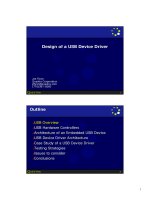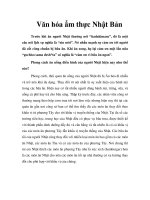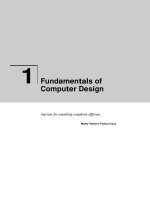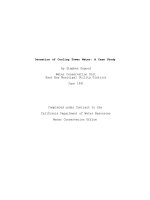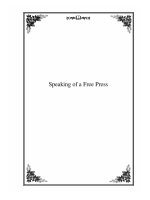Tài liệu Eye of a Dog docx
Bạn đang xem bản rút gọn của tài liệu. Xem và tải ngay bản đầy đủ của tài liệu tại đây (944 KB, 10 trang )
OF A DOG
Brenda Hoddinott
I-03 INTERMEDIATE:
CARTOONS & CRITTERS
This simple project, features an eye of Shadow the Dalmatian, and is drawn completely freehand.
After sketching the outlines, you add different values with help from four different grades of
pencils, 2H, HB, 4B, and 6B. Throughout the lesson, I discuss the process of rendering a
simplified drawing from a detailed photograph.
The key to simplifying a drawing when working from a photograph is to make sure you are very
familiar with the visual structure of your subject. Artists often become frustrated and
overwhelmed by too much visual information when trying to visually simplify a complex image
and subsequently draw it accurately.
“Eye of a Dog” is divided into the following three sections:
THE PARTS OF A DOG’S EYE: To draw a dog’s eye correctly, you first need to find out
as much as possible about its various parts.
ESTABLISHING DOG EYE PROPORTIONS: Drawing Shadow’s eye enhances your
visual abilities, by exercising your freehand drawing skills. In this section, your goal is to
sketch her eye proportionately correct.
BRINGING THE EYE TO LIFE WITH SHADING: Gather your drawing pencils and
prepare to add shading to Shadow’s eye. In addition to its basic triangular shape, a realistic
dog’s eye drawn from this angle, needs to illustrate its three dimensional forms as defined by
a light source, in this case from the right.
Suggested drawing supplies include good quality white drawing paper, 2H, HB, 4B, and 6B
graphite pencils, kneaded and vinyl erasers, and a pencil sharpener.
This project is recommended for fine art educators, and artists
from age 12 to adult with limited drawing skills.
10 PAGES – 15 ILLUSTRATIONS
Published by Hoddinott Fine Art Publishers, Halifax, NS, Canada – 2004 (Revised 2006)
Copyright to all articles, images, text, projects, lessons and exercises within this drawing class belong to Brenda Hoddinott and may
not be reproduced or used for any commercial purposes whatsoever without the written permission of Brenda Hoddinott.
Web sites and
- 2 -
ILLUSTRATION 03-01
ILLUSTRATION 03-02
THE PARTS OF A DOG’S EYE
Artists often become overwhelmed by too much visual information when trying to simplify a
complex image.
The drawing in this project is based on this photograph of
the eye of a Dalmatian named Shadow. Observe that the
iris, pupil, and two tiny segments of the white of the eye
take up most of the visible sections.
In order to draw a dog’s eye correctly, you first need to
find out as much as possible about its various parts. Refer
to the drawing below, and identify each of the following.
1. Iris: the large circular shape that varies in value from
very light to very dark. Tiny muscles in the iris
radiate outward from the pupil to help it open and
close. In profile, the eyeball is not a perfect sphere;
the cornea of the iris bulges slightly outward.
2. White of the Eye: the primary section of the eyeball. The white of the eye is generally
rendered with light to medium values.
3. Outer Corner: the outermost section of the eye.
4. Upper Eyelid: a movable fold of skin that opens and closes to protect the eyeball.
5. Highlight: a bright spot(s) or section(s) where light bounces off the shiny surface of the eye.
6. Pupil: the dark circle inside the iris often has the darkest values of the entire drawing. The
pupil of an eye is similar to the aperture in the lens of a camera; it opens and closes, as the
levels of light become brighter or darker.
7. Inner
corner: a
small
triangular
shape in
the inside
corner of
the eye.
8. Lower
eyelid: a
fold of
skin
protecting
the lower
section of
the
eyeball.
Copyright to all articles, images, text, projects, lessons and exercises within this drawing class belong to Brenda Hoddinott and may
not be reproduced or used for any commercial purposes whatsoever without the written permission of Brenda Hoddinott.
Web sites and
- 3 -
ESTABLISHING DOG EYE PROPORTIONS
Drawing Shadow’s eye enhances your visual abilities, by exercising your freehand drawing
skills. In this first section, your goal is to sketch her eye proportionately correct. Proportion is
the relationship in size of one component of a drawing to another or others.
1) Use slightly curved lines to draw a triangular shape with rounded corners.
Examine the next three step-by-step drawings. Curved lines are created when a straight line
curves (or bends). Shape refers to the outward outline of a form. Basic shapes include
circles, squares and triangles.
ILLUSTRATION 03-03 ILLUSTRATION 03-04
ILLUSTRATION 03-05
Use an HB pencil, and keep your lines very
light so they can be easily erased.
Pay close attention to the lengths,
angles, and curves of the various lines.
For example, take note that the lower
line is more rounded than the other two
and the curved line on the right is
shorter than the others.
Constantly
double check the
proportions of your
sketch as you work your
way through this project,
and modify if needed.
Copyright to all articles, images, text, projects, lessons and exercises within this drawing class belong to Brenda Hoddinott and may
not be reproduced or used for any commercial purposes whatsoever without the written permission of Brenda Hoddinott.
Web sites and
- 4 -
ILLUSTRATION 03-06
2) Add another curved line inside
the triangular shape.
Take note of the points where the
line intersects two sides of the
triangular shape. Also, this line is
more curved at the top.
ILLUSTRATION 03-07
3) Add two more curved lines to
represent the outline of the iris of
the eye.
Refer to Illustrations 03-07 and 03-
08.
ILLUSTRATION 03-08
While these two curved lines outline a
segment of a round shape, the upper
and lower sections appear to be
under the dog’s eyelids.
Turn your
drawing around in
various directions, and
view it from different
perspectives, to double
check that the iris looks
like a round shape.
Copyright to all articles, images, text, projects, lessons and exercises within this drawing class belong to Brenda Hoddinott and may
not be reproduced or used for any commercial purposes whatsoever without the written permission of Brenda Hoddinott.
Web sites and
- 5 -
ILLUSTRATION 03-09
4) Outline a highlight in the upper
right section of the iris.
The light source is from
the right. Light source
refers to the direction
from which a dominant
light originates. The
light source tells you
where to draw all the
light values and
shadows.
In the interest of
originality, feel
free to make
your highlight
an oval, circle
shape, or even a
curved teardrop-
shape.
ILLUSTRATION 03-10
5) Draw a circular shape inside the iris
as the pupil.
The pupil is quite small when
compared to the iris.
Take note that the highlight
appears to overlap the
pupil.
Also, because
of the angle of
the eye, the
pupil is drawn
closer to the
right of the
iris than the
left.
